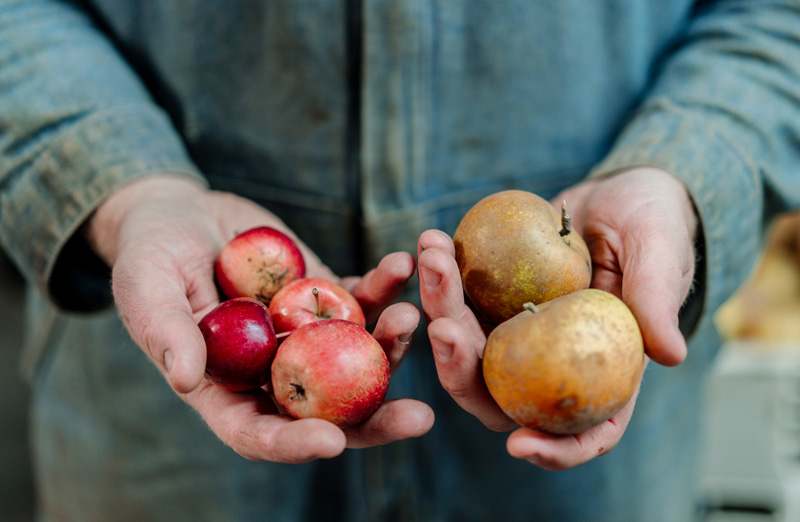PHOTOGRAPHS BY BECCA DILLEY / HEAVY TABLE
When you step onto the production floor of Milk and Honey Ciders, the aroma of apples drapes itself across you like a weighted blanket. With the possible exception of dairy plants on cheesemaking days, nothing I’ve ever inhaled can hold a candle to the sensory overload at the cidery’s picturesque facility on the outskirts of St. Joseph, Minn.
It’s not merely that the smell of 120,000 pounds of apples is intense. It’s also that the aroma deeply layered, with herbal, bitter, sweet, earthy, and tannic notes mingling into a cacophonous olfactory jam session.
THE SWEET APPEAL OF BITTER FLAVORS
On the late October day we visit the cidery, a crew of a half dozen people is pressing apples to make the company’s 2021 vintage Fauna, a cider that evolves each year with changing weather conditions and each year’s resultant apple crop.
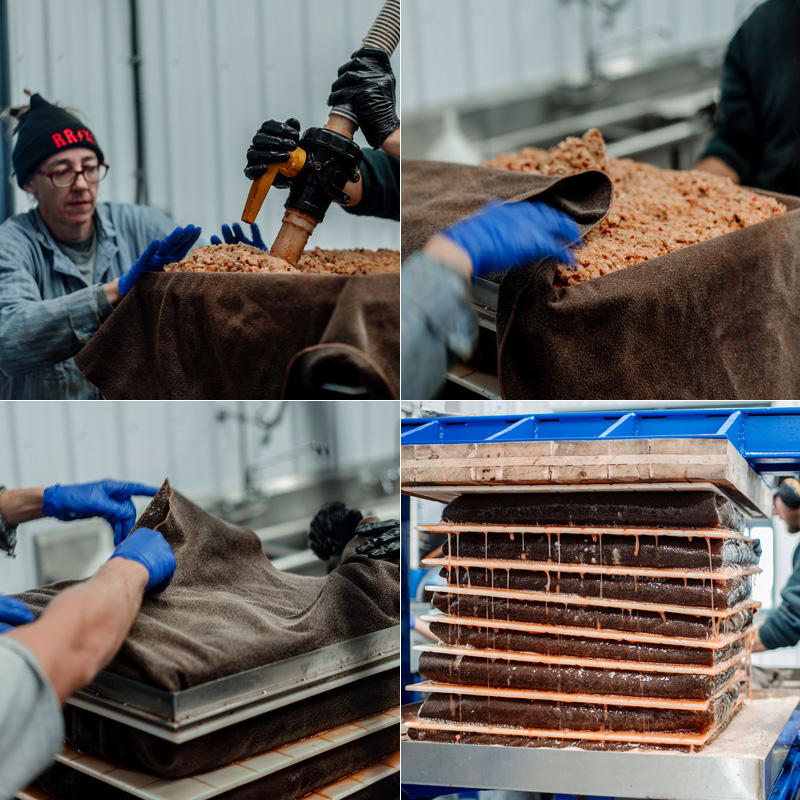 Despite the machinery involved in the process, watching the team work feels like traveling back to pre-industrial times. It’s a small group of people, working with their hands, trusting one another, moving in rhythm as they share a small space and wrest hundreds of gallons of juice from thousands of pounds of apples.
Despite the machinery involved in the process, watching the team work feels like traveling back to pre-industrial times. It’s a small group of people, working with their hands, trusting one another, moving in rhythm as they share a small space and wrest hundreds of gallons of juice from thousands of pounds of apples.
The mix for Fauna includes bittersharp and sharp apples from Poverty Lane Orchards in New Hampshire. Milk and Honey co-founder Peter Gillitzer describes their apples as some of the best fruit in the country. The Poverty Lane apples are combined with local bittersweet Wickson crab apples from the company’s Cold Spring orchard to balance the profile of the cider.

“I love bittersweets,” says Gillitzer. “That long finish you get now in the fruit will also be in the finished cider.” Despite their seemingly off-putting nature, bitter tannins are a signal to the primitive bits of the human brain that nutrition is on its way: “Us, as glorified monkeys, really crave tannins,” he says. “When you think about it – chocolate, coffee, cider – once you have one, you really crave another one. Even after you eat it, you’re still enjoying it. Whereas with these acid varieties [of apples], you finish eating it and you’re done.”
Gillitzer’s job on the day we visit is driving a forklift and skillfully maneuvering massive payloads of apples into the slide that marks the start of the company’s short-but-efficient production line.
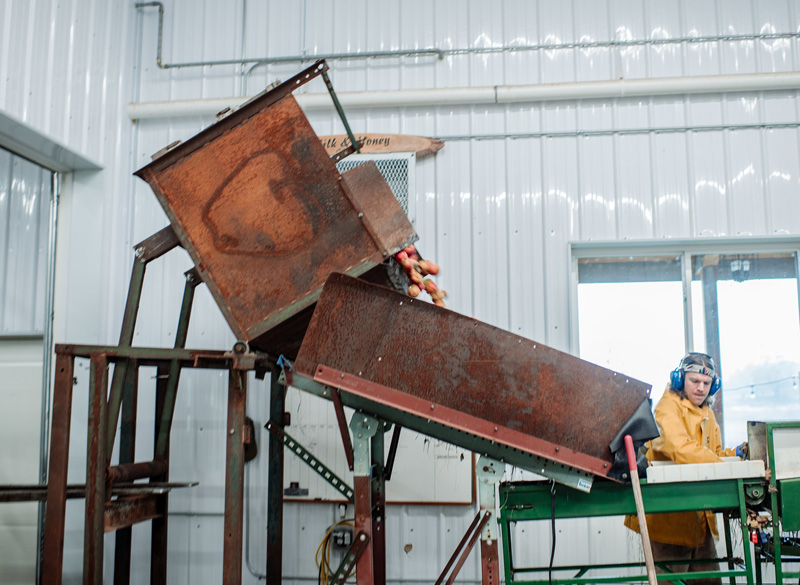
After being dumped by forklift into the company’s cider line, the apples are agitated to remove leaves and branches, scrubbed thoroughly, and trucked upwards to their grim fate…
FULL COURT PRESS
…which is being smashed down into pomace, the liquidish mass of crushed apples and juice that is then pumped over to the cider press part of the operation. At this early stage in the operation, the mix and character of the apples is already important. With the wrong fruit, the apples won’t pump properly over to the press, or press correctly when pressure is applied.
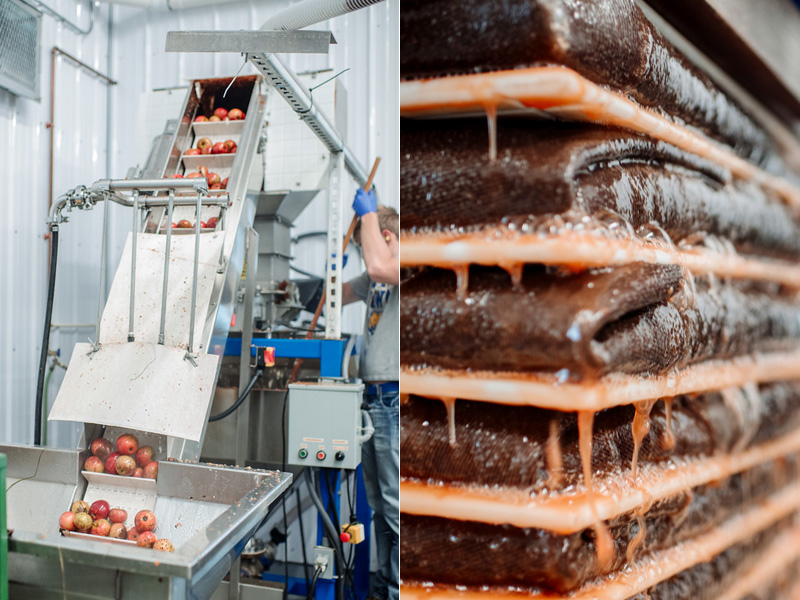 “[Apples] always change every year, depending upon the weather,” says Gillitzer. “To get the pumping to work you’ve got to mix wet apples with dry apples, and to get the press to work you need to mix hard apples with soft apples, or the press goes all wavy-gravy and you don’t get good extraction.” Getting the right pH is critical, too, he notes. “If we did all bittersweets we’d be over 4 and the titratable acidity would be off, which opens you up to spoilage.”
“[Apples] always change every year, depending upon the weather,” says Gillitzer. “To get the pumping to work you’ve got to mix wet apples with dry apples, and to get the press to work you need to mix hard apples with soft apples, or the press goes all wavy-gravy and you don’t get good extraction.” Getting the right pH is critical, too, he notes. “If we did all bittersweets we’d be over 4 and the titratable acidity would be off, which opens you up to spoilage.”
Milk and Honey uses a rack and cloth press to extract juice from its apples, a labor intensive method that involves multiple workers pumping over pomace, covering the material with cloth, and squeezing layers of the fruit through the fine material in order to collect the juice.
“No one uses that,” says Gillitzer of the company’s old-school rack and cloth press. “You get really high yields and high quality juice. But most people will use something more automated, like a squeeze box. [With rack and cloth] you get really intense pressure and really small spaces.”
That precision takes a lot of additional worker power, but the cidery’s old-fashioned approach yields more juice (2.8 to 3.5 gallons of juice a bushel versus about 2-2.5 in a belt press) and allows for more control over the finished product. “You get really good filtration with this, it leaves a lot of the pectin and fine particulates behind,” says Gillitzer.
FROM PRESS TO TABLE
Once the juice is extracted, it’s off to the tanks to ferment and evolve with the help of benign microorganisms from a thick, lovely apple juice (which we drank fresh off the press in the cidery’s rustic taproom) into one of the company’s varieties of hard cider. Fermenting takes four weeks, and it’s followed by a six month cellaring process.
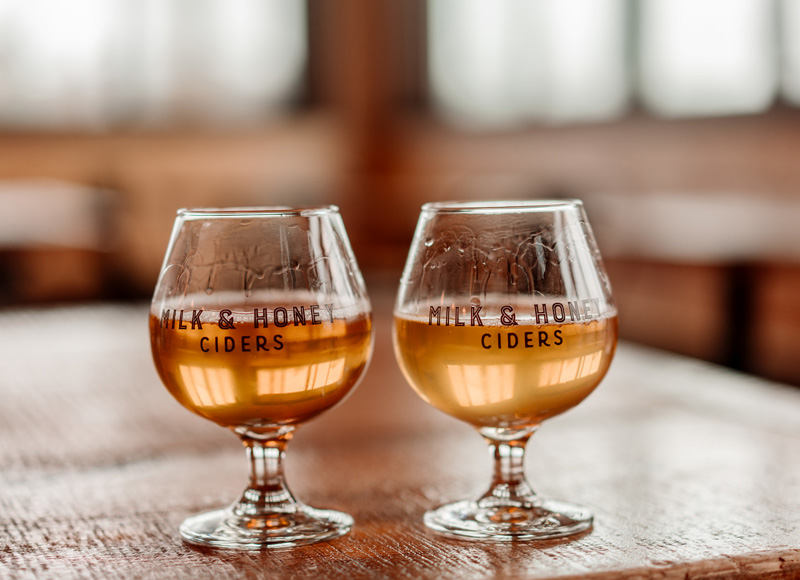
We tried a couple types of Milk and Honey ciders: Fauna, which had a clean apple flavor with a complex, lovely herbal nose, and Estate, which brought enough body and crisp minerality to effectively stand in for a good Spanish or Portuguese white wine.
As for the future of the now nearly 10-year-old Milk and Honey Cider tradition, Gillitzer would like to grow more – or perhaps all – of the fruit the company uses locally in Minnesota. “We’re figuring it out,” he says. “We’re working with the U [of Minnesota], they’ve been great, trying to figure out the hardiness of some of these varieties and how to grow them here,” he says. “It’s totally different here than where they’re from, in England. Those are all Chisel Jersey apples off of 10-15 year old trees from New Jersey. We put in an acre here, so the idea is we will do it.”
Will Minnesota bittersweet cider apples rival those grown in England and New Hampshire? “We’re making some investments,” says Gillitzer. “As soon as we figure out, ‘hey, this is a good, tannic, bittersweet cider apple,’ we’re willing to make the investment. It’s a big risk.”


